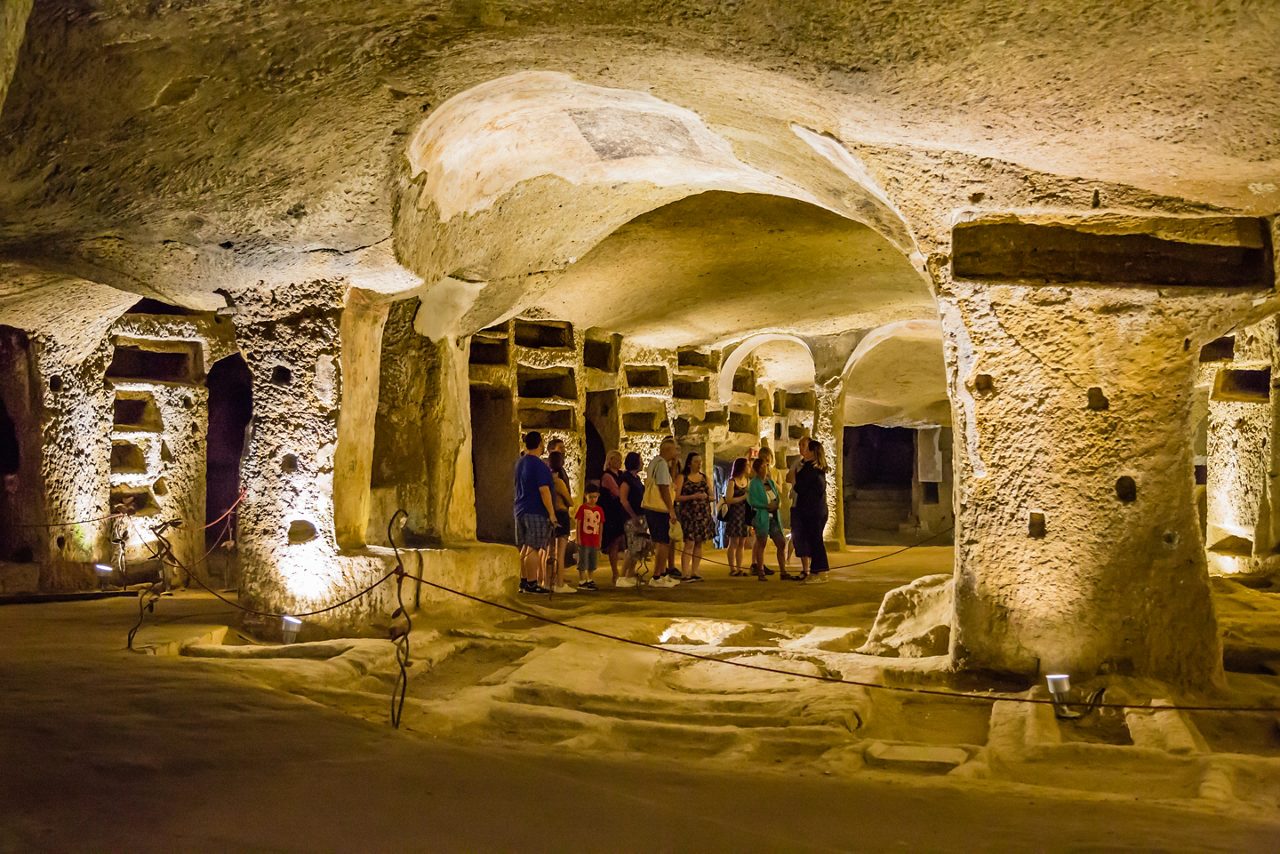The Catacombs of San Gennaro are the largest cemetery areas in all of southern Italy, as well as among the largest in all of the State. They are located underground in Naples, specifically in the Sanità district. Their entrance is located on Via Capodimonte, adjacent to the Basilica del Buen Consiglio. We are located in the center of the city, certainly one of the most characteristic and historically dense areas.
Did you know that you can visit Catacombe for free by purchasing the Naples Pass?
Not only are they vast and fascinating, these are also the catacombs where the remains of St. Gennaro, the city's patron saint, were translated. Which gives further mystical and almost affective value towards this mysterious place, certainly all to be discovered.
The history of Catacombs of St. Gennaro
The origin of the Catacombs dates back to the turn of the second and third centuries AD, the period of origin of the first family found within them. However, the name of the said Roman family is not known, remaining unknown due to the loss of epigraphic material. Only its noble origin is known, nothing else. Along the third century the vestibule of the lower floor was created, where shortly afterwards the remains of St. Agrippinus, sixth bishop of Naples and the city's first patron, ended up there. In the 5th century Bishop John I had the remains of St. Gennaro, killed in 305, moved to the lower catacomb. From that time on, that place became a center of worship of the martyr, hence then the appellation Catacombs of St. Gennaro.

From the time of the spiritual elevation of the catacomb where Saint Gennaro lay, the whole complex gradually assumed more importance and richness. It became a true center of worship where people went to pay tribute to the martyr. An early highlight was 831, when the Lombard ruler Sicon I besieged Naples. He took possession of the remains of St. Gennaro and brought them to Benevento, his city and episcopal see. There followed years of decay, almost degradation, for the catacombs, which were tremendously neglected and ignored.
Beginning in the 18th century, scholars resumed their studies of the catacombs. In addition, these became a popular destination for visitors on the Grand Tour. This was a journey through Europe that the high aristocracy used to undertake from 1700 onward. This went on in crescendo, up to the contemporary age and the present day. Along World War II, the catacombs were crucial as a refuge from bombing.
In 1969, Corrado Ursi, cardinal archbishop of Naples, had the catacombs reorganized and inaugurated a new excavation campaign. During the latter, scholars discovered the Crypt of the Bishops and the Tomb of San Gennaro. Since 2006, the Catacombs of St. Gennaro have also and mostly been open to the general public, whereas before they were mostly the subject of studies and research.
The Catacombs of St. Gennaro nowadays
The Catacombs of San Gennaro are arranged on two levels that do not overlap each other, both characterized by extremely large spaces. As already mentioned, the starting point was the tomb of a patrician family, later expanded with the remains of St. Agrippinus. It is from the Basilica of the aforementioned saint that the lower catacomb develops, according to a lattice structure carved into the tuff. The imposing lower vestibule, with ceilings capable of touching up to 6 meters in height, houses a large baptismal font commissioned by Bishop Paul II. The latter was most famous for taking refuge in the catacombs to escape the iconoclastic struggles in the 8th century.

The Upper Catacomb can also be traced back to the ancient burial place of bishops. It originates from an ancient tomb from the 3rd century AD that preserves some of the earliest Christian paintings in southern Italy. It was thanks to the translation of the remains of St. Gennaro (5th century AD) that the first expansion of the catacomb, its first elevation, took place. In fact, after his burial, there was the formation of the Crypt of the Bishops, where the city's bishops were buried, and the majestic basilica adjecta, a three-aisled underground basilica.
The tomb of St. Gennaro was found through the study of a homily dated between the 9th and 10th centuries, as well as a passage from the Chronicon of the bishops of Naples. All, of course, still in the upper level of the catacombs. The tomb was in a cubiculum, identified in the one below the bishops' basilica. From the tomb sprang the changes to the level above, with the creation of a room reserved for the burial of bishops and basilicas; the latter were much larger spaces than the other chapels reserved for the common dead.
Nowadays, the
Catacombs of San Gennaro are a hotspot for history and art lovers, but also and especially for the
faithful. We are talking about a place of worship of imperious caliber, to say the least, a place of
pilgrimage that welcomes visitors from all over the world. Among its advantages, one must also count membership in the
Naples Pass, a means that helps to make the most of the experience in the catacombs.
In short, all that remains is to move to visit the catacombs. However, it should be kept in mind that the temperatures in their interior always fluctuate between 15° and 22°, all year round. So, you should dress comfortably and be ready for this adventure to be discovered and experienced!












Lascia un commento